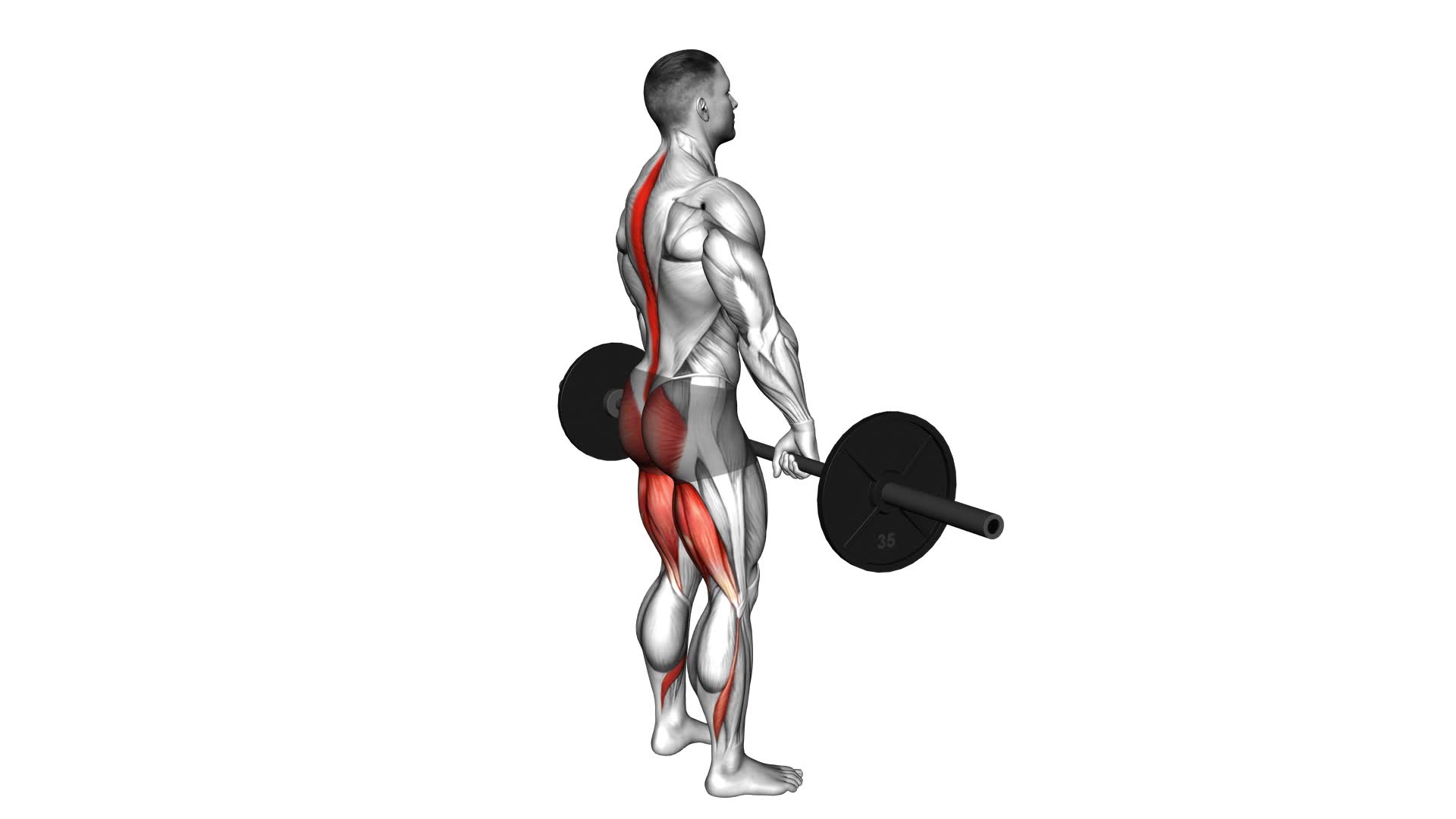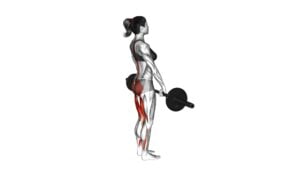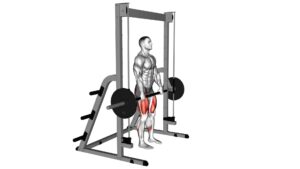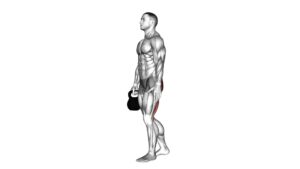Barbell Stiff Legged Deadlift – Video Exercise Guide & Tips

In this video exercise guide, you'll learn how to properly perform the Barbell Stiff-Legged Deadlift. This challenging exercise targets your hamstrings, glutes, and lower back, helping to build strength and improve your overall fitness.
Watch This Exercise Video
You'll discover the correct form and technique, as well as common mistakes to avoid.
With variations and progressions, you can customize your workout to suit your fitness level.
Follow these tips for a safe and effective workout that will leave you feeling strong and accomplished.
Key Takeaways
- Barbell stiff-legged deadlifts target the posterior chain muscles, including the glutes, hamstrings, and lower back.
- These exercises improve lower body strength, stability, and hip mobility.
- They also increase grip strength and offer variations for targeting muscles in different ways.
- Incorporating barbell stiff-legged deadlifts into your workout routine can lead to increased strength, muscle development, and overall performance.
Benefits of Barbell Stiff-Legged Deadlifts
To maximize your gains, incorporate barbell stiff-legged deadlifts into your workout routine. This exercise offers numerous benefits that can enhance your overall fitness and strength gains.
One of the main benefits of barbell stiff-legged deadlifts is their ability to target the posterior chain muscles, including the glutes, hamstrings, and lower back. By activating these muscles, you can improve your overall lower body strength and stability. Additionally, this exercise helps to improve hip mobility and flexibility. By performing barbell stiff-legged deadlifts, you can also enhance your grip strength, as you need to maintain a secure grip on the barbell throughout the movement.
There are also various variations of barbell stiff-legged deadlifts that you can incorporate into your routine. You can perform this exercise with a conventional barbell, or you can also use a trap bar to target the muscles in a slightly different way. Another variation is the single-leg stiff-legged deadlift, which further challenges your balance and stability. Additionally, you can modify the range of motion by using blocks or plates to elevate the barbell.
Now that you're aware of the benefits and variations of barbell stiff-legged deadlifts, it's essential to focus on proper form and technique to maximize the effectiveness of this exercise.
Proper Form and Technique
To perform the barbell stiff-legged deadlift with proper form and technique, it's crucial to focus on three key points.
First, master the hip hinge movement, which involves pushing your hips back while keeping your back straight.
Second, maintain proper alignment by ensuring your back stays flat and neutral throughout the exercise.
Lastly, engage your glute muscles to generate power and stability during the movement.
Hip Hinge Movement
Mastering the hip hinge movement is crucial for performing the barbell stiff legged deadlift with proper form and technique.
The hip hinge is a fundamental movement pattern that involves flexing at the hips while maintaining a neutral spine. It's essential because it helps activate the posterior chain muscles, including the glutes, hamstrings, and lower back.
To execute the hip hinge correctly, start by standing with your feet shoulder-width apart, engage your core, and push your hips back as you lean forward. Keep your knees slightly bent and maintain a straight back throughout the movement.
Focus on feeling the stretch in your hamstrings as you hinge forward.
Once you have mastered the hip hinge, you can progress to the next section about back straight alignment.
Back Straight Alignment
Maintain a straight back throughout the barbell stiff legged deadlift exercise to ensure proper form and technique. Keeping a straight back posture is crucial for preventing injuries and maximizing the effectiveness of the exercise.
When performing the stiff legged deadlift, it's important to engage your core muscles for stability and support. This will help maintain the alignment of your spine and prevent rounding or arching of the back.
To achieve a straight back, focus on keeping your chest lifted, shoulder blades pulled back, and abs engaged. Avoid any excessive forward bending or rounding of the upper back.
Engaging Glute Muscles
Are you engaging your glute muscles properly during the barbell stiff legged deadlift exercise? Glute activation and muscle engagement are crucial for performing this exercise correctly and maximizing its benefits.
To engage your glutes effectively, start by standing with your feet hip-width apart and the barbell in front of you. As you hinge at your hips and lower the barbell towards the ground, focus on squeezing your glutes to drive your hips forward in the upward phase of the movement. This will activate your glute muscles and help you maintain proper form throughout the exercise.
Remember to keep your back straight and shoulders pulled back for optimal glute engagement. By consciously activating your glutes, you can ensure that you're targeting this muscle group effectively during the barbell stiff legged deadlift.
Common Mistakes to Avoid
To ensure you're performing the barbell stiff legged deadlift correctly and avoiding common mistakes, it's important to be aware of harmful form techniques.
One common mistake to avoid is rounding your back during the exercise, as this can put excessive strain on your spine.
Additionally, make sure to focus on proper hip hinge technique, as this will engage your glutes and hamstrings effectively while minimizing stress on your lower back.
Harmful Form Techniques
Avoid the harmful form techniques that can lead to injury when performing the barbell stiff legged deadlift. To prevent common injuries and ensure a safe and effective workout, keep the following tips in mind:
- Maintain proper posture: Keep your back straight and shoulders back throughout the movement to avoid straining your lower back.
- Engage your core: By bracing your core muscles, you provide stability and protect your spine from excessive stress.
- Use a suitable weight: Start with a weight that allows you to maintain proper form and gradually increase as your strength improves.
- Control the movement: Avoid using momentum and focus on a slow and controlled descent to maximize muscle activation and minimize the risk of injury.
Proper Hip Hinge Technique
To execute the barbell stiff legged deadlift with proper hip hinge technique, focus on maintaining a neutral spine throughout the movement. The hip hinge is a fundamental movement pattern that involves bending at the hips while keeping a slight bend in the knees. This movement is crucial for exercises like the stiff legged deadlift, as it helps engage the posterior chain muscles, including the glutes, hamstrings, and lower back.
Variations and Progressions
To progress and challenge yourself with the barbell stiff-legged deadlift, you can incorporate variations into your training routine. These variations not only add excitement to your workouts but also target different muscle groups for increased muscle activation.
Here are four variations you can try:
- Romanian Deadlift (RDL): This variation emphasizes the movement of the hips and hamstrings. Instead of starting with the barbell on the floor, you begin with the barbell at thigh level, keeping a slight bend in your knees throughout the exercise.
- Deficit Deadlift: By standing on a raised platform or using weight plates, you increase the range of motion for the deadlift. This variation targets the hamstrings and glutes even more, making it a challenging progression.
- Single-Leg Deadlift: This variation adds an element of balance and stability. Instead of using both legs, you stand on one leg while performing the deadlift. It engages the core and improves unilateral strength.
- Sumo Deadlift: This variation involves a wider stance with the toes pointed outwards. It targets the inner thighs, quadriceps, and glutes, providing a different stimulus to the muscles.
Incorporating these variations into your barbell stiff-legged deadlift routine won't only keep your workouts interesting but also help you challenge different muscle groups for better overall strength and development.
Tips for a Safe and Effective Workout
Ensure proper form and maximize your results by incorporating these tips for a safe and effective barbell stiff-legged deadlift workout.
First and foremost, safety should be your top priority during any workout. Before starting your barbell stiff-legged deadlifts, make sure to warm up properly. This will help increase blood flow to your muscles and reduce the risk of injury.
Additionally, it's crucial to maintain a neutral spine throughout the exercise. Engage your core and keep your back straight to avoid straining your lower back.
To perform the exercise effectively, start with a lighter weight and gradually increase as you become more comfortable with the movement. This will allow your body to adapt and build strength over time. Remember to always use proper lifting techniques, such as keeping your chest up, shoulders back, and hinging at the hips.
Another tip for a safe workout is to avoid rounding your back or locking your knees during the exercise. These movements can put unnecessary strain on your spine and joints. Instead, focus on maintaining proper form and engaging your glutes and hamstrings as you lift the barbell.
Lastly, listen to your body. If you experience any pain or discomfort during the exercise, stop immediately and consult a healthcare professional. It's better to be cautious and prevent injuries than to push through and potentially cause further harm.
Sample Barbell Stiff-Legged Deadlift Routine
For an effective barbell stiff-legged deadlift routine, incorporate a variety of exercises that target your glutes, hamstrings, and lower back. By including different exercises, you can maximize the benefits of this compound movement and ensure a well-rounded workout. Here are four key exercises to consider:
- Romanian Deadlifts: This variation focuses on the eccentric phase of the movement, emphasizing the stretch and activation of the hamstrings. Start with the barbell at hip level and hinge at the hips while keeping a slight bend in the knees. Lower the barbell down your legs, maintaining a neutral spine, and then return to the starting position.
- Good Mornings: This exercise primarily targets the lower back while also engaging the hamstrings and glutes. Begin by placing the barbell across your upper back, standing with your feet shoulder-width apart. Hinge at the hips while keeping your spine neutral, lowering your torso until parallel to the floor. Then, return to the starting position by activating your glutes and hamstrings.
- Single-Leg Romanian Deadlifts: This exercise is excellent for improving balance and unilateral strength. Hold the barbell in front of your thighs and shift your weight onto one leg. Hinge at the hips while extending the opposite leg backward, maintaining a neutral spine. Return to the starting position and repeat on the other leg.
- Deficit Deadlifts: This variation increases the range of motion, challenging your hamstrings and glutes even more. Stand on a small platform or weight plates, allowing the barbell to hang lower than usual. Perform the deadlift as you normally would, focusing on maintaining proper form throughout the movement.
Incorporating these exercises into your barbell stiff-legged deadlift routine will help you reap the benefits of increased strength, muscle development, and improved overall performance. Plus, the variety will keep your workouts interesting and prevent plateaus. Remember to start with lighter weights and gradually increase the load as you progress.
Frequently Asked Questions
Can I Perform Barbell Stiff-Legged Deadlifts if I Have Lower Back Pain or a Previous Lower Back Injury?
If you have lower back pain or a previous lower back injury, it's important to exercise caution when performing barbell stiff-legged deadlifts. These exercises can put additional stress on your lower back, potentially exacerbating your pain or injury.
It's advisable to seek modifications for barbell stiff-legged deadlifts that can reduce the strain on your lower back, such as using lighter weights, adjusting your form, or exploring alternative exercises that target the same muscle groups.
How Often Should I Incorporate Barbell Stiff-Legged Deadlifts Into My Workout Routine?
To incorporate deadlift variations into your workout routine, it's important to consider the benefits of stiff-legged deadlifts. These exercises can strengthen your hamstrings, glutes, and lower back.
However, it's crucial to proceed with caution if you have lower back pain or a previous injury. Start by incorporating barbell stiff-legged deadlifts once or twice a week, gradually increasing the frequency as your strength and form improve.
Remember to always listen to your body and consult with a professional if needed.
Are Barbell Stiff-Legged Deadlifts Suitable for Beginners or Should They Be Reserved for More Advanced Lifters?
Beginners and advanced lifters can both benefit from barbell stiff-legged deadlifts. This exercise targets the hamstrings, glutes, and lower back, helping to strengthen and tone those muscle groups.
Beginners should start with lighter weights and focus on proper form before progressing to heavier loads.
Advanced lifters can challenge themselves by increasing the weight and intensity of the exercise.
Remember to always warm up and consult a fitness professional for guidance, especially if you're new to this movement.
Can Barbell Stiff-Legged Deadlifts Help Improve My Posture?
Barbell stiff-legged deadlifts can indeed help improve your posture. By performing this exercise, you can enhance your flexibility and activate key muscles in your posterior chain.
This increased muscle activation and improved flexibility can contribute to better posture over time. So, incorporating barbell stiff-legged deadlifts into your workout routine can be beneficial for posture improvement, especially when done correctly and consistently.
Is It Necessary to Use a Weightlifting Belt When Performing Barbell Stiff-Legged Deadlifts?
When performing barbell stiff-legged deadlifts, you may wonder if using a weightlifting belt is necessary. While it isn't mandatory, a weightlifting belt can provide extra support and stability to your core.
However, if you prefer to avoid using a belt, there are alternative exercises you can incorporate into your routine that target similar muscle groups, such as Romanian deadlifts or hip thrusts.
Ultimately, the decision to use a weightlifting belt is up to your personal preference and comfort level.
Conclusion
In conclusion, the barbell stiff-legged deadlift is a highly effective exercise for targeting the hamstrings, glutes, and lower back. By maintaining proper form and technique, you can maximize the benefits of this exercise while minimizing the risk of injury.
Avoid common mistakes such as rounding the back or lifting with the arms, and consider incorporating variations and progressions to challenge your muscles further.
Remember to always prioritize safety and consult with a fitness professional if needed.

Author
Years ago, the spark of my life’s passion ignited in my mind the moment I stepped into the local gym for the first time. The inaugural bead of perspiration, the initial endeavor, the very first surge of endorphins, and a sense of pride that washed over me post-workout marked the beginning of my deep-seated interest in strength sports, fitness, and sports nutrition. This very curiosity blossomed rapidly into a profound fascination, propelling me to earn a Master’s degree in Physical Education from the Academy of Physical Education in Krakow, followed by a Sports Manager diploma from the Jagiellonian University. My journey of growth led me to gain more specialized qualifications, such as being a certified personal trainer with a focus on sports dietetics, a lifeguard, and an instructor for wellness and corrective gymnastics. Theoretical knowledge paired seamlessly with practical experience, reinforcing my belief that the transformation of individuals under my guidance was also a reflection of my personal growth. This belief holds true even today. Each day, I strive to push the boundaries and explore new realms. These realms gently elevate me to greater heights. The unique combination of passion for my field and the continuous quest for growth fuels my drive to break new ground.







